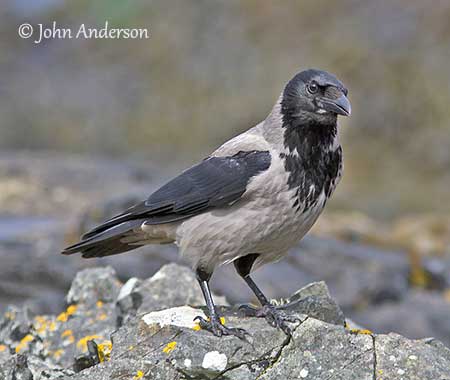
Fr: Corneille mantelée
Ang: Hooded Crow
All: Nebelkrähe
Esp: Corneja Cenicienta
Ita: Cornacchia grigia
Nd: Bonte Kraai
Sd: gråkråka
Photographers:
John Anderson
John Anderson Photo Galleries
Didier Buysse
Vision d’Oiseaux
Jean Michel Fenerole
Photos d’Oiseaux du monde
Steve Garvie
RAINBIRDER Photo galleries & Flickr Rainbirder
Jean-Claude Jamoulle
A la rencontre des Oiseaux
Jean Marc Rabby
Des Ailes et des Plumes
Ingo Waschkies
Bird Photography
Text by Nicole Bouglouan
Sources:
HANDBOOK OF THE BIRDS OF THE WORLD Vol 14 by Josep del Hoyo-Andrew Elliot-David Christie - Lynx Edicions – ISBN: 9788496553507
THE COMPLETE BOOK OF BRITISH BIRDS – Written by “Royal Society for the Protection of Birds” experts - Préface de Magnus Magnusson - Michael Cady- Rob Hume Editors - ISBN: 0749509112
THE HANDBOOK OF BIRD IDENTIFICATION FOR EUROPE AND THE WESTERN PALEARCTIC by Mark Beaman, Steve Madge - C. Helm - ISBN: 0713639601
BIRDS OF THE MIDDLE EAST by R.F. Porter, S. Christensen, P Schiermacker-Ansen C.Helm - ISBN: 0713670169
Wikipedia, the free encyclopaedia
Arthur Grosset's Birds (Arthur Grosset)
Why Evolution is True - A tale of two crows
Hooded Crow
Corvus cornix
Passeriformes Order – Corvidae Family
INTRODUCTION:
The Hooded Crow was formerly a subspecies of the Carrion Crow, but it is now considered a full species. However, both species are very closely related and interbreed sometimes.
Like most of Corvidae, the Hooded Crow is opportunistic and takes advantage of whatever is available. It is omnivorous and feeds on a wide variety of food items, from plant material to animal food and carrion. It breeds in N and E Europe, and moves S in autumn. It frequents farmland and open woodland, heaths, coasts, towns and urban parks.
The Hooded Crow is not globally threatened, but it has been persecuted and considered a pest by farmers, as a threat of the livestock. The species is legally protected, but it can be shot or trapped, and its nests destroyed, due to its bad reputation.
The Hooded Crow is mentioned in folklore, literature and legends. It is often considered a harbinger of danger.

DESCRIPTION OF THE BIRD:
Biometrics:
Length: 48-54 cm
Wingspan: 84-100 cm
Weight: 396-600 g
Except the plumage, the Hooded Crow is very similar to the Carrion Crow.
The adult of nominate race has two-colour plumage with greyish-white body and black wings, tail, head and large bib. The remaining underparts and axillaries are ashy grey with narrow dark streaks.
The powerful bill is black. The eyes are dark brown. Legs and feet are dark grey.
Male and female are similar.
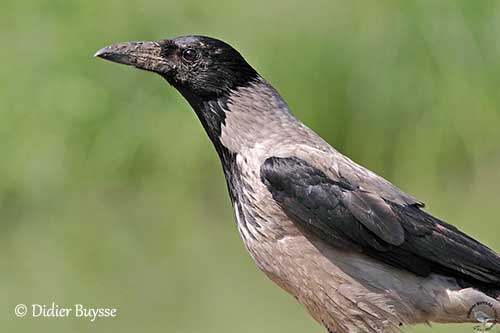
The juvenile is duller with washed-brown-grey plumage. The eyes are greyer and the interior of mandibles is pinkish-red (dark grey in adults). At hatching, the chick is much blacker than the adults.
Hybrids C. cornix x C. corone show blackish markings on mantle or lower underparts. But they have variable appearance, and some birds are almost completely black with scattered grey feathers on mantle and breast.
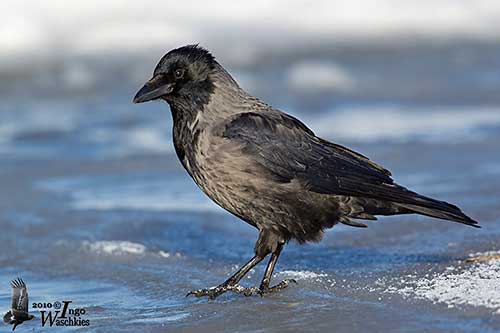
SUBSPECIES AND RANGE:
The Hooded Crow has four subspecies.
C.c. cornix breeds on Faroe Islands, N Scotland, Ireland and I of Man, E throughout Fennoscandia and W Russia to Urals, S in Europe to Hungary and NW Romania, N Balkans, N Italy and Corsica. Some northern populations move S/SW in winter, and may reach W France.
C.c. sharpii is found in Urals, E in Siberia to R Yenisei, C Asia, Iran, Turkey (except S), from Caucasus W through S Ukraine to S Balkans, Crete and S Italy, including Sardinia and Sicily. The northern populations move S as far as Afghanistan.
This race is paler grey than nominate, with larger W birds than E ones.
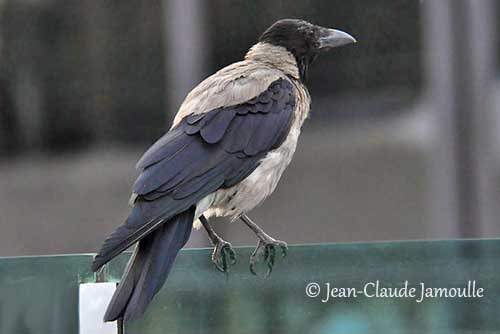
C.c. sharpii
Turkey
C.c. pallescens occurs in Cyprus, S Turkey E to N Iraq, S to Egypt, Israel and Jordan.
This one is smaller and paler grey than “sharpii”.
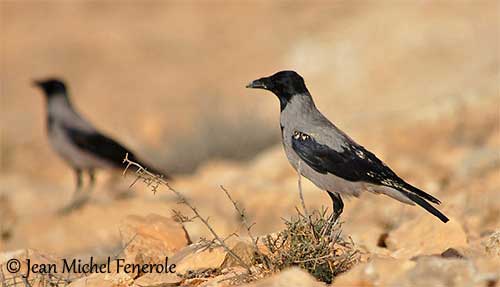
C.c. pallescens
Israel
C.c. capellanus is found in Euphrates valley of lowland Iraq, and E into SW Iran.
This race has large, stout bill, and the body plumage is very pale grey, giving the bird a black-and-white appearance, especially in worn plumage.
HABITAT:
The Hooded Crow frequents a wide variety of habitats such as clearings, woodland edges, cultivated areas with scattered trees, parks and gardens in city centres, coastal cliffs, moorland, inshore islands and estuaries.
It breeds at high elevation in some parts of the range, from 1350 to 2050 metres.
CALLS AND SONGS: SOUNDS BY XENO-CANTO
The Hooded Crow gives a hoarse croaking “krarrk, krarrk” often repeated. This sound is usually softer, more rolling and less hoarse than that of Carrion Crow. A series of repeated knocking sounds acts as a song.
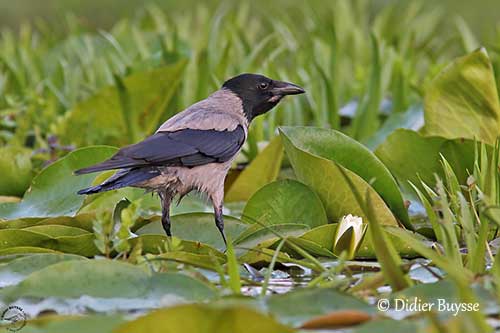
BEHAVIOUR IN THE WILD:
The Hooded Crow is omnivorous and feeds on a variety of food items including carrion. It usually consumes berries, insects, molluscs, eggs of other bird species and carrion.
It picks and probes with the bill, turns over stones, moves sticks and pushes grass on the side while searching for food. In shorter grass, it also hunts by sight. In urban areas, parks and gardens, it becomes very opportunistic and takes advantage of potential food items such as discarded human food. In coastal areas, it frequently collects mussels and other sea shells, taking them in the bill, then flying and dropping them onto the rocks below, in order to break them open and get the flesh.
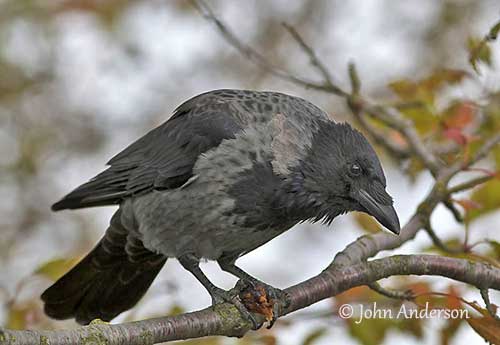
The Hooded Crow is monogamous with long-term pair-bond, and both mates often remain together all year round. This species is a solitary breeder, but sometimes, they form loose colonies.
Apparent communal breeding behaviour has been reported from Scotland where a trio of crows defended a territory as a group, and a nest contained 9 eggs.
In territorial defence, they perform threat displays towards the intruders. The crown approaches with the head held up, the bill pointed upwards and the plumage slicked. Bill-snapping is also used as a threat.
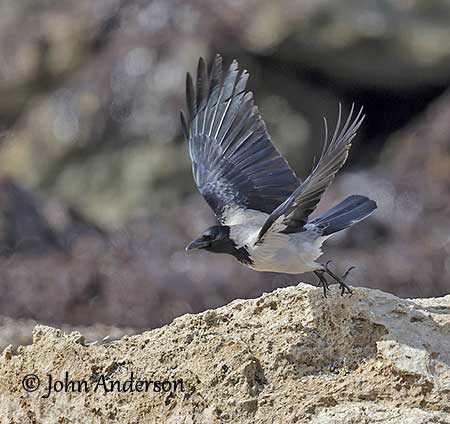
C.c. pallescens
Cyprus
The Hooded Crow is resident in W and S of the range, whereas N and interior populations move S in autumn. Numerous birds may remain in towns during milder winters, even in far north.
The migrating crows move S in September/November, and the spring migration occurs in March/May. Flocks of thousands are reported at key points.
The Hooded Crow makes continuous, fairly long, strong flights with deliberate wingbeats.
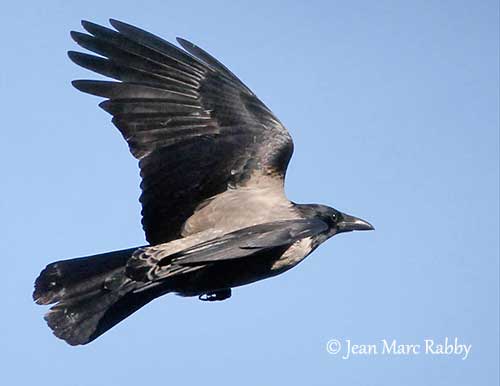
REPRODUCTION OF THIS SPECIES:
The breeding season varies depending on the range. It starts in late March in Britain, with the egg-laying at mid-April. In the southern parts of the range, it takes place from late January to May, and further N from mid-April to May.
The Hooded Crow produces a single brood per season. It breeds solitary, but they can form loose colonies with well-spaced nests (20 metres).
Both adults take part in nest-building, with the male collecting nest materials and the female building the cup-shaped structure during one week. The nest is made with sticks and twigs, sometimes mixed with animal bones. Then, she adds wool and heather, and she pushes mud into the foundation. The deep cup is lined with a thick layer of wool, fur, and soft materials.
This nest is generally built in crown of tall tree, but depending on nest-site availability, it can be placed on pylons, cliff ledges, bush or dense low vegetation, sometimes even on the ground, protected by vegetation or rocks.
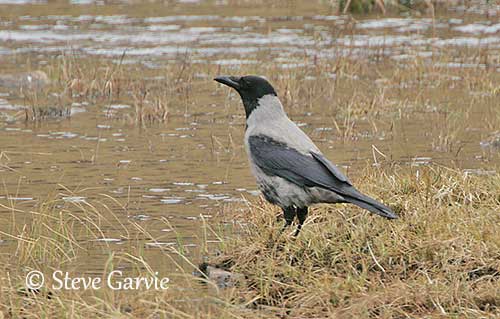
The female lays 4-5 pale blue eggs with dark markings. She incubates during 17-20 days. Both parents feed the chicks that fledge between 3 and 5 weeks after hatching. They still depend on parents for 2-3 weeks more, and they may remain in family group during the first winter. The young are sexually mature at 2-3 years old.
PROTECTION / THREATS / STATUS:
The Hooded Crow has wide range and a large, increasing population in most European countries. This increase follows a long period of human persecution, when this crow was considered a pest by farmers.
The population has not been quantified, but it is estimated at several millions individuals.
The Hooded Crow is currently evaluated as Least Concern.
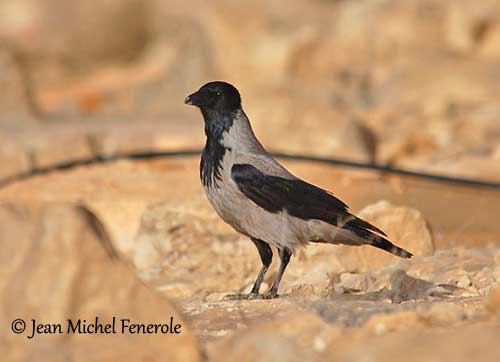
C.c. pallescens
Israel